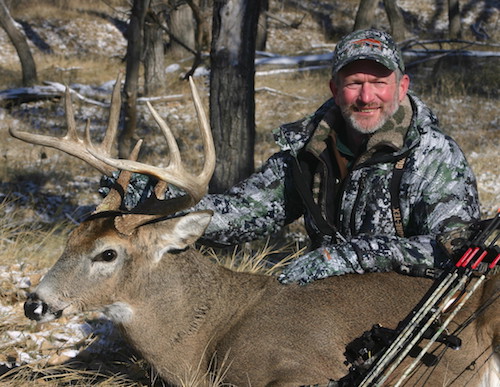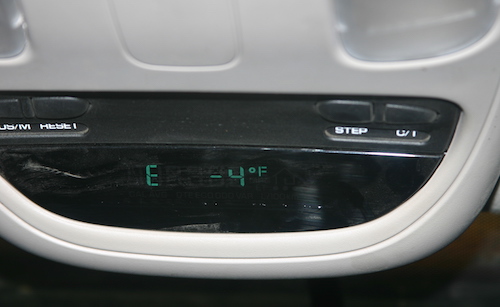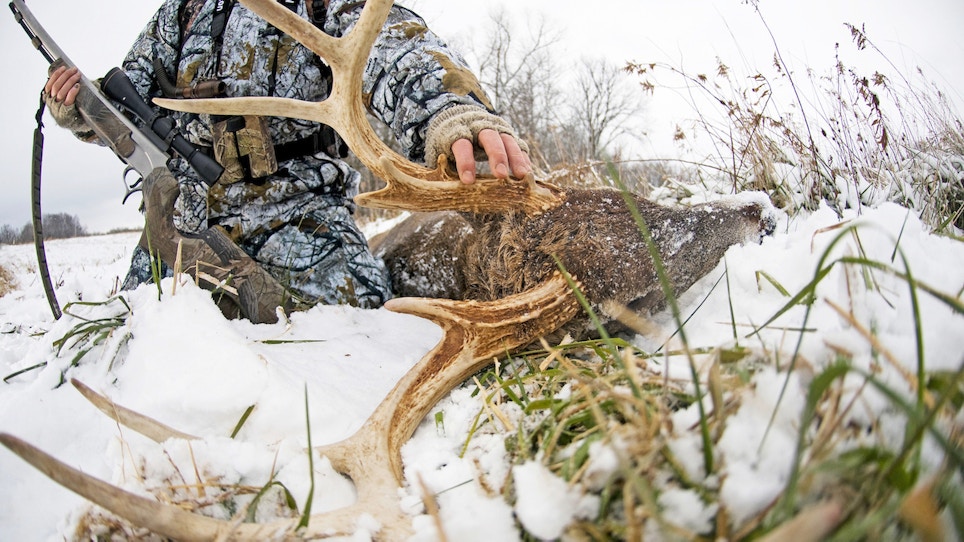 This winter has been weird. It's been too warm and dry in many places for sure, but the Alberta Clipper started roaring across much of the country last week bringing cold, wind, and snow along with some good news for hunters looking to fill a late-season deer tag.
This winter has been weird. It's been too warm and dry in many places for sure, but the Alberta Clipper started roaring across much of the country last week bringing cold, wind, and snow along with some good news for hunters looking to fill a late-season deer tag.
Here’s how to punch it.
10) Hunt the food
Pretty simple theory, really. Following a rough rut and the onset of a cold winter, bucks need calories and lots of them. Put them on a feeding pattern and go get ‘em. The key, however, is scouting, and never letting the deer know you’re there. That means employing a lot of trail cameras and using optics to glass from a distance as you ferret out buck locations and feeding patterns. The best food? Corn, pure and simple. Also good are standing beans, brassicas, and cereal grains.
Related: What deer eat in winter
9) Locate forbs
If you don’t have crops or food plots to hunt what do you do? Simple. Seek out quality forage where deer feel secure. Don’t overlook forbs, which can make up 60 percent or more of a deer’s diet. Look for sunny southern slopes where weeds and wild flowers might still be green and growing. These slopes can be 10 percent warmer than shaded slopes and often deer bed there as well.
8) Sleep in

One thing late-season bowhunters must make sure of is that their bowstring will clear the puffier sleeves and chest of their cold-weather clothing. Bob Robb took this dandy buck in SW Kansas of a 4 degree afternoon. Photo: Bob Robb
Late season hunting — especially when the ground is frozen and it sounds like a freight train whenever and wherever you walk — is an afternoon affair, pure and simple. Don’t be tempted to hunt mornings, you’ll just end up frozen and, odds are, alert deer that something’s amiss. My experience has shown the best movement comes between 10:00 a.m.-1:00 p.m., and 3:00 p.m.-dark. Also, never, ever let deer in a food plot see you leave. And remember to be just as careful checking cameras as when hunting. You can't let scent go into those bedding areas.
7) Patience, patience, patience
Spend way more time observing than hunting. By setting up at a distance and glassing the source, a buck’s trail can be pinpointed and clues are often provided on where the deer are coming from. It can also show you where to hide out and wait for him as well as the best ways to access and egress the area. Also remember that sound travels seemingly forever on cold, calm days. I try and set up at least 100 yards off the trail (when I’m hunting with a firearm).
6) Look for daylight activity
I don’t care a whit about after-hours trail cam pics this time of year. I need pictures of bucks in daylight. Run your cameras on a time lapse or field scan mode — where the camera takes a photo every minute during the last 90 minutes of each day — then check them at midday. As soon as you see a good buck on camera during the day, hunt him as soon as possible, that very night, if you can.
Related: Best late-season plants for deer
5) The importance of cover
For bowhunters, tree selection is a huge area of concern. With no leaves on the trees, most of your early or midseason trees are now probably useless since they afford no cover. Now you must find trees with background cover — other trees behind you or branches on the tree you’re in, whatever keeps you from having an open sky that will silhouette you against the sky. If conifers are available, they’re the ticket. Also make sure you're ultra-quiet when sitting in a stand: no squeaks or moans to give you away on those calm afternoons.
4) Weather fronts
This time of year the worse the weather is, the better the hunting can be. Colder, nastier weather means the deer need to eat more than usual, so they’ll be moving more during the day. I especially like that first afternoon of relative calm after a big storm. You can be sure deer movement will be big, so get out there.
3) Take the track
Following a big snow is when those gun hunters who love to track a buck down are all atwitter. Start in the morning and try to locate a big buck that was made the night before. Odds are he’ll bed down and you can get aggressive. My friends who are good at this track aggressively and, if they jump the buck up, they are ecstatic. If he escapes, they don’t care. They sit down, have a snack, wait 30-60 minutes and continue on. It’s often the second or third time they come upon the buck they get their shot.
Related: Late season bowhunting success tips
2) Push bush
Here's a last-minute tactic with my friends and I but, when we’re down to a day or two left in the season and we haven’t gotten it done, we organize little mini-drives and push bush. We drive near known bedding areas and keep it small and controlled — no more than two drivers and two standers. All we’re trying to do is get them up and moving, not running for their lives. We set the standers downwind of the area we’re pushing, with the drivers coming in upwind or with a little crossing breeze.
1) Stay warm, stay safe

The worse the weather, the better the hunting can be as bucks seek out lots of food now. Photo: Bob Robb
Over two decades of December hunting in nasty weather, I’ve learned a few things.
But No. 1 on the list is simply this: safety first. You have to dress warmly enough from head to toe or you can’t be efficient on stand. There have been days so windy, icy and nasty I didn’t feel safe climbing into a tree stand, so I stayed on the ground. Commercial ground blinds will freeze and crackle like potato chips, so I never use them anymore. Instead, I build little ground blinds out of logs, brush and some burlap or camouflage netting and make sure I can sit on a padded seat and not the ground, which is way warmer. A shooting house is The Bomb, if you can use one. A muff filled with disposable handwarmers is a Godsend. I’ve been known to tape more hand and body warmers to my chest and back and use toe warmers as well inside my Pac boots (that are three sizes too large for me so air can circulate). Every night the boots go on an electric boot dryer to remove all moisture.
Bottom line: Temperatures closer to zero than freezing in windy conditions can kill you quick, so always respect Mother Nature.
Featured photo: John Hafner






